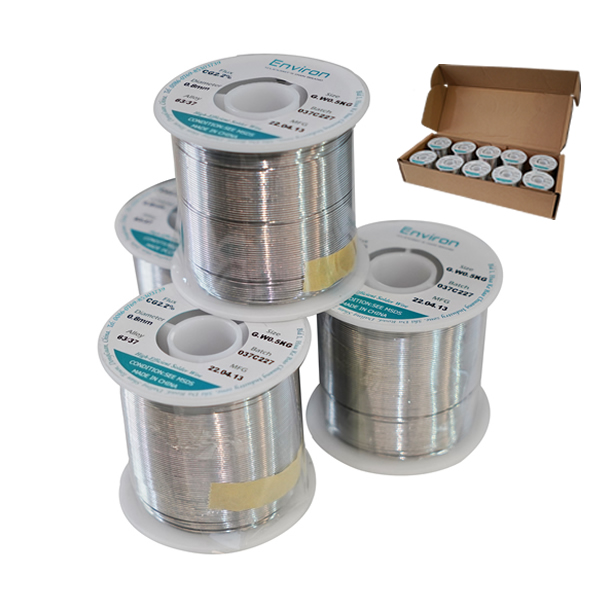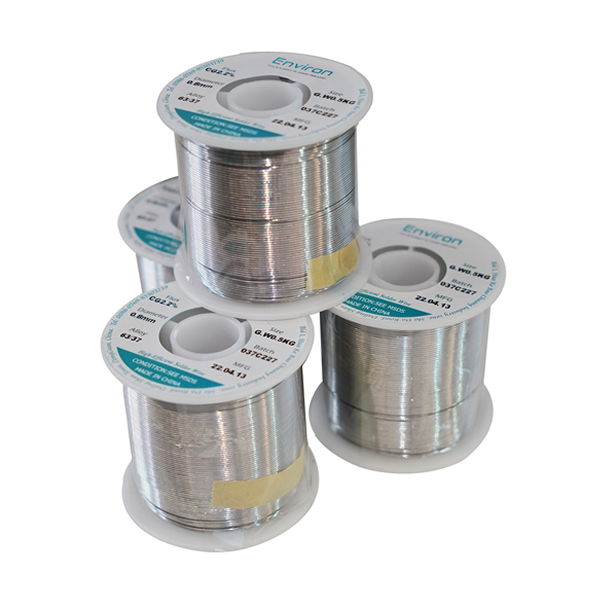- Call us now: (+86)0769-85303739
- Email: sales@1clicksmt.com
Sn63/Pb37 Solder Wire
No-clean solder wire is the most effective solder with RMA resin core for manual/automatic soldering. This type of cored solder has a unique activation system that provides rapid wettability compared to other RMA cored solders. Its flux which features low residue does not require cleaning and is acceptable in appearance. It can meet GB/T3131-2001 impurity composition control requirements.
Available Options
Sn63/Pb37 Solder Wire
×Suitable applicable for any electronic parts’manual and automatic soldering. It is also suitable for the production of commercial-purpose electronic equipment which conforms to national standards, including electronic computers, aircrafts, radio-based communication equipment, automation equipment, commercial and entertainment machines. RMA resin’s compositions are non-conductive in nature and become active only at the activation temperature. When activation temperature is reduced to the room temperature, they resume their dull state, so the post-solder residue after cooled is highly insulative. RMA resin core’s activation system can solder the following (even moderately gasified) metals such as silver, solder for electroplating, solder for thermal deposition, nickel for electroplating, copper, silver, pure tin for thermal deposition, pure tin for electroplating.
|
Sn63/Pb37 solder wire Features: |
|
|
No-clean solder wire is the most effective solder with RMA resin core for manual/automatic soldering. This type of cored solder has a unique activation system that provides rapid wettability compared to other RMA cored solders. Its flux which features low residue does not require cleaning and is acceptable in appearance. It can meet GB/T3131-2001 impurity composition control requirements. |
|
|
|
|
|
Metal compositions and contents |
|
|
Metal compositions meet industry specifications as follows: |
|
|
General standards |
|
|
Flux content |
□ Solid core □F1 (1.1-1.5%) □F2 (1.6-2.0%) □F3 (2.1-2.5%) □F4 (2.6-3.0%), etc. |
|
Alloy content |
□63/37 □60/40 □55/45 □50/50 □45/55 □40/60, etc. |
|
Diameter |
0.2~12mm, or tailor-made |
|
Weight per roll |
□500g □800g □1000g, etc. |
|
Sn63/Pb37 solder wire Alloy compositions: |
||||
|
Description |
Sn63/37 solder wire |
Specification | Sn63/Pb37 | |
|
Seq |
Test items |
Contents (in WT%) |
||
|
Alloy compositions are based on the following industry standards |
||||
|
1 |
Tin (Sn) |
63±1.5 |
||
|
2 |
Lead (Pb) |
The rest |
||
|
Impurity limit ≤ |
||||
|
3 |
Stibium (Sb) |
≤1.5 |
||
|
4 |
Bismuth (Bi) |
0.1 |
||
|
5 |
Iron (Fe) |
0.02 |
||
|
6 |
Arsenic (As) |
0.03 |
||
|
7 |
Copper (Cu) |
0.05 |
||
|
8 |
Zinc (Zn) |
0.002 |
||
|
9 |
Alumimium (Al) |
0.005 |
||
|
10 |
Cadmium (Cd) |
0.01 |
||
|
Note: The above alloys were determined by densitometry. Final tin content = tin content + antimony content |
||||
|
Flux’s physical and chemical properties |
||
|
The flux used as solder core belongs to no-clean (NC) type with moderate activity, good soldering effect, transparent residue, non-viscosity, non-corrosiveness and fast wetting. So, it is suitable for high-quality electronic products and can meet the requirements of manual or automatic or fast soldering, especially for soldering process that needs extremely good appearance. |
||
|
|
||
|
Seq |
Item |
Requirements |
|
1 |
Flux content |
2.2%±0.2% or tailor-made |
|
2 |
Flux continuity |
Uniform flux content without breakage or emptiness |
|
3 |
Chlorine content (wt%) |
≤0.1~0.5 or tailor-formulated |
|
4 |
Copper clad laminate corrosion (4d) |
No obvious difference or corrosion signs compared with standard clad laminate |
|
5 |
Copper mirror corrosion |
No exposed bottom |
|
6 |
Extension rate (%) |
≥85 |
|
7 |
Residue dryness |
Powder can be easily removed from any specimen |
|
8 |
Solid-phase wire |
183℃ |
|
9 |
SLiquid-phase wire |
183℃ |
|
Packing and labelling |
|
1. Packing per roll |
|
● Packed in roll with plastic reel core. |
|
● Label which indicate alloy compositions, wire diameter, rosin content and unit weight. |
|
● Each roll is wrapped with a piece of paper to protect the product. |
|
|
|
2. Packing per carton |
|
● Paper cartons are used. |
|
● Ten rolls per carton. |
|
● Label which indicate alloy compositions, wire diameter, rosin content and unit weight. |
|
|
|
3. Packing standards |
|
● Labels are clear and complete. |
|
● Solder wires are wound in a neat and uniform way with no tangling and flattening. |
|
● Tin wire surfaces are kept clean and intact. |
|
|
|
4. A certain length of extension wire should be guaranteed |
|
|
|
5. Shelf life: One year when stored between 0~40℃ |
|
|
|
6. Precautions: Stored in a dry and ventilated place and keep away from moisture |



Add a review
Your email address will not be published. Required fields are marked